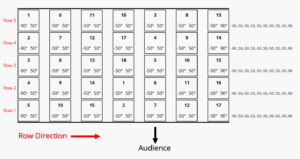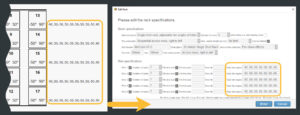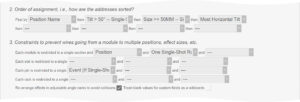Fan row racks like the AVM SFX-20 racks, or the CraigCo MinCom racks, or the PyroDigiT PLS30E/45P+ racks can be configured in Finale 3D with pre-defined tube holder angles of your choice, or with adjustable tube holder angles that accommodate effects at any angle (see Fan row racks). In the real world, though, many fan row racks have physical constraints that restrict the tube holders to angle ranges.

Figure 1 – Tube holders on the row ends may be able to lean more than tube holders in the middle of rows.
Often the angle ranges are different depending on whether the tube holders are on the ends of the rows or in the interiors, as shown in Figure 1. To accommodate these physical constraints, Finale 3D supports angle range specifications in the rack definitions like “-90..50” to indicate a range from minus 90 degrees to positive 50 degrees.

Figure 2 – Tube holder angle and angle ranges are written as comma separated lists.
Tube angle range constraints are only supported for one rack structure, as chosen in the rack definition dialog: Single-shot rack, adjustable fan angles of tubes in each row; or more colloquially, “Fan row racks”. The tube holder angle range specifications go into the “Tube fan angles” fields for each row, as shown in Figure 2.

Figure 3 – The comma separated lists are held in the “Tube fan angle” fields for the rows.
Figure 3 shows a definition for the CraigCo MinCom X7 35 Shot Rack. When defining racks in Finale 3D, it is imperative that the rows of the rack definition match the rows of the physical rack. Looking carefully at the rack in Figure 1, you can see seven rotation rods with clamps. The square tube holders rotate around the rotation rods. In rack definitions, the “rows” are perpendicular to the rotation rods. Thus this rack has five rows. Just count the number of tube holders on a rod — five!
The language used in rack definitions, such as the pre-wired pin order “By rows, left to right”, refers to rows vertically, aiming toward the audience. In shows, most single-shot racks need to be rotated 90° counter-clockwise from this orientation to accommodate left/right angles, which is typically how you would see them in the rack layout view in Finale 3D. To avoid making you read the rack’s name and pin numbers as sideways text, the rack definition has the option of defining the “standard orientation” to be rotated 90° counter-clockwise. Finale 3D also draws the clamps on the ends of the rods, so you can always tell which ways the tube holders can rotate. Please see Rack “row” and standard orientation for more information.
The specifications of Figure 1 indicate the tube holders on the ends of the rows can aim outward horizontally at 90 degrees. The tube holders in the interiors of the rows are restricted to 50 or 53 degrees, depending on the end tube holders. Angle ranges in Finale 3D can’t have dependencies, so the conservative definition of allowable angles for these rows is: -90..50,-50..50,-50..50,-50..50,-50..90.
Syntax for angles in the “Tube fan angles” field
The “Tube fan angles” field can be blank, meaning no restrictions on the angle, or it can contain a comma-separated list of specific angles or angle ranges. Angle ranges are in the syntax “X..Y” as in the previous examples. Specific angles are just numbers (“X”), and are equivalent to “X..X”. Since it is inconvenient to write -180..180 to mean no restriction for a particular tube holder, the syntax also supports leaving elements in the comma-separate list blank. A blank element is equivalent to -180..180. Thus “-180..180,-180..180,-180..180,-180..180,-180..180” has the same meaning as “,,,,”
Sorting by “Most Horizontal Tilt — Single-Shot”
Racks with angle ranges require some accommodations when addressing the show. When the tube holders don’t all have the same angle ranges, which is usually the case if you are using angle ranges, then the addressing algorithm that assigns tube holders to effects can make bad decisions about which effects to put in which tube holders.
The decisions won’t technically be wrong, because they will always satisfy the angle constraints you specify, but the decisions may not use the tube holders that have the best fitting angle ranges for the effects assigned to them. A simple example is this: imagine a show that contains just ten effects, five aiming horizontally to the left and five aiming vertically straight up; the show will use one or more adjustable fan angle racks like that shown in Figure 1, with five fan rows. If the addressing function first assigns the straight up effects to the tube holders on the left ends of the rows (the only tube holders capable of aiming fully to the left), then none of the other tube holders could accommodate the remaining five effects. The addressing function would need add extra racks to accommodate the remaining effects, even though a single rack could accommodate the eight effects if they were placed in the right tube holders.
The addressing sort criterion “Most Horizontal Tilt — Single-Shot” offers a solution for misallocating tube holders at the ends of rack rows. Sorting by “Most Horizontal Tilt — Single-Shot” first, the addressing function will seek first to find tube holders for the effects with the most extreme angles, those fitting only in the end tube holders. Returning to the example of ten effects with five aiming horizontally and five vertically, the horizontally aiming effects will be assigned first while the tube holders on the left ends of the rack rows are still available. The remaining five effects fill easily into any tube holders. Thus the ten effects require only a single rack.
The “Most Horizontal Tilt — Single-Shot” sorting criterion applies equivalently to left leaning and right leaning effects, causing the rack rows to fill from the ends toward the center if the end tube holders are configured with the extreme angle ranges. For the common physical specifications of racks like the one shown in Figure 1, filling from the ends results in a balanced and efficient use of the tube holders.
A really good addressing dialog configuration for racks with angle range constraints
If a launch position contains single-shot racks of different kinds, and if some of the racks can hold larger effects than others, then the addressing algorithm needs to consider both the angle and the size of the effect. The sort criteria must prioritize both considerations: large effects that can only fit in the large tube holder racks, and effects tilted more than 50° that can only fit in the end tube holders. The addressing dialog configuration of Figure 5 works in almost all circumstances. The terms are explained in detail in Table 2 and Table 3 of Racks with pre-wired pins.

Figure 5 – Combining “Tilt > 50° — Single-Shot” with “Size >= 50MM — Single-Shot” optimizes for both size and angle.
Combining “Tilt > 50° — Single-Shot” with “Size >= 50MM — Single-Shot” optimizes for both size and angle. The “Tilt > 50°” term prioritizes the effects that can only fit in the end tube holders, and the “Size >= 50MM” term ensures that of those prioritized effects, the large ones that need the end tube holders of the large tube holder racks are allocated first. The “Most Horizontal Tilt — Single-Shot” term is included in the addressing dialog configuration as a lower priority just to cause racks to fill with a balanced set of left and right leaning effects.
Since the sort criterion intermingle left and right leaning effects, the addressing algorithm tends to allocate interior tube holders aiming toward each other on colliding paths. The “Re-arrange effects in adjustable angle racks to avoid collisions” option at the bottom of Figure 5 fixes the colliding angles by re-arranging the tube holder assignments at the end of the addressing function after their initial assignments (see Re-arrange effects in adjustable angle racks to avoid collisions). This function is guaranteed to resolve all collisions as long as the most extreme angle ranges in the rack definitions are at the ends of the rows.
Using “fake” pre-wired pins to achieve a nice ordering of pins in the rack
You may not care about the pin order within the rack, but if you do care, the addressing dialog configuration of Figure 5 doesn’t achieve high marks by itself. Since the effects are assigned to tube holders on the ends first, and then the tube holder assignments are rearranged, the end result is anything but a natural counting sequence of pin numbers along the rack rows. If that is what you want, you can use the “Pre-wired pins” option for racks as described in Racks with pre-wired pins to achieve an excellent result.